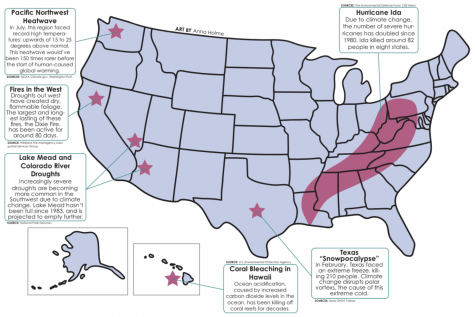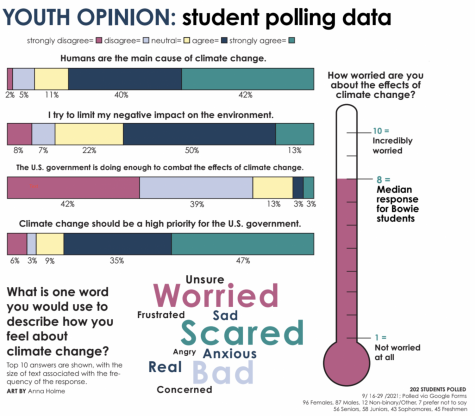CLIMATE CHANGE: rising temperatures with a rising generation

In the midst of a climate change crisis, many younger generations have been speaking out and promoting activism.
November 2, 2021
Droughts, rising temperatures, floods, heat waves, storms. According to the United States Geological Survey (USGS), these are a few of the symptoms of climate change. National Geographic defines climate change as “the long-term alteration of temperature and typical weather patterns in a place.” In reference to Earth, climate change helps to explain many of the unusual environmental phenomena that have appeared in recent years.
In the United States specifically, eight out of the 10 warmest years on record have been recorded since 1998, according to the U.S. Environmental Protection Agency (EPA). Additionally, since the late 1800s, Earth’s global temperature has risen about one degree Celsius, which many experts consider to be a startling change in such a short period of time.
“There’s now much more evidence of climate change over the past 30 or so years,” environmental science teacher Alonna Beatty said. “We have instrumentation to measure these things now, which means that we can provide cold, hard facts that show trends in data that show human impact. Climate change is much more irrefutable than it was a few decades ago.”
With this acceleration in what many consider a “climate crisis,” questions have arisen regarding what the future of Earth entails. Especially among younger generations, discourse has emerged regarding the spiraling conditions of the planet’s climate.
“I’m scared for future generations and how they’ll be impacted because so far we’re only affected very indirectly by climate change,” freshman Samantha Seiter said. “But once things get worse then younger generations will have to deal with it in everyday life and make accommodations for those changes.”
These concerns are reflective of current climate trends. Many experts in the scientific community predict that Earth will continue experiencing escalating environmental conditions.
“We can expect a significant jump in extreme weather over the next 20 or 30 years,” climate scientist Piers Forster said in a recent interview with the New York Times. “Things are unfortunately likely to get worse than they are today.”
EFFECTS ON PHYSICAL HEALTH
Apart from its effects on the environment, climate change has been shown to have many effects on the physical conditions of humans as well. Earth’s ever-adjusting climate has been linked to many health issues. The American Academy of Pediatrics (AAP) states that factors such as heat stress, poor air quality, food insecurity, and changing disease patterns are direct results of climate change.
“I have a lot of family in India,” Earth Club president senior Taru Mishra said. “The last time I visited them, the effects of smog were so prevalent. When I walked into the New Delhi airport, I could barely

breathe. I was coughing the entire time. My cousins, who are natives there, were used to it. But I have a little bit of asthma, and I felt like I was dying. It’s come to the point where you can’t even see clear skies.”
Respiratory problems, like asthma, are one of the health issues that are becoming more common due to air pollution. These effects are especially noticeable in adolescents. The EPA found in a study that children ages 11 and younger were more susceptible to harmful air particles. In general, research has shown that children are more susceptible to climate-related health problems. The AAP estimated that 88 percent of climate change-related diseases affected those under the age of five.
“Young kids are getting more and more admissions to the [emergency room] and the hospital with asthma exacerbations due to poor air quality,” pulmonologist Dr. Mickey Sachdeva said in an interview with NPR. “We’re seeing more heat exhaustion and heat-related illnesses. With climate change happening, the number of these cases will keep rising.”
EFFECTS ON MENTAL HEALTH
Besides just physical health, climate change has been shown to exacerbate mental health issues as well. In what has now been dubbed “eco-anxiety” or “climate anxiety,” thoughts of climate change have been linked to worsening mental health conditions such as depression, anxiety disorders, and substance abuse.
“I definitely think that with climate change, there is this ever-encompassing dread,” Amnesty International Club co-president junior Jake Stachura said. “There is uncertainty that I won’t have a good life in my future. That affects me and my decisions now, if I do something is it even worth it? If I’m going shopping for something, I have to be conscious of hey, how does this affect the environment? Does this increase pollution? Does this increase carbon emissions? Is it green? Is it locally sourced? How does it affect the climate?”
A study by GlobeScan found that 59 percent of children in Generation Z have a strong desire to change their lifestyles to be more environmentally friendly. Many report that this stems from a fear of the future conditions of Earth’s climate.
“We know [climate change] is going to come to haunt us in the future and that previous generations haven’t taken enough action to combat it,” Mishra said. “Especially for Generation Z and future generations, we’re going to have to take immediate actions towards ending climate change. Seeing my peers not align with me on these views about issues that are so important to me, and should be so important to other people, definitely impacts my mental health in a negative way.”
According to the Pew Research Center, Generation Z and Millennials are more active when discussing climate change. Consequently, many younger Americans are more likely to be affected by eco-anxiety: a recent study published in Lancet Planetary Health reported that 45 percent of 16 to 25 year olds are negatively affected by climate-related anxiety. From the same study, 46 percent of young Americans believe that “humanity is doomed.”
“Just the fear of floods and droughts and horrible disasters that can happen, and are happening, in increasing amounts,” Stachura said. “You don’t know what’s going to happen next. There’s kind of a depression, there’s so little you can actually do about it. You feel helpless. I feel helpless.”
ACTIVISM AND CAREERS
With all these adverse effects being perpetuated by climate change, many adolescents are attempting to re-take control of Earth’s climate. A survey by the United Nations (UN) found that 89 percent of youths think young people will help mitigate the effects of climate change. But with this hope has also caused some to resent the lack of response from the government.

“You have stolen my dreams and my childhood with your empty words,” teenage environmental activist Greta Thunberg said in her famed speech to world leaders at the UN Climate Action Summit. “And yet I’m one of the lucky ones. People are suffering. People are dying. Entire ecosystems are collapsing. We are in the beginning of a mass extinction, and all you can talk about is money and fairy tales of eternal economic growth. How dare you.”
In 2019, over four million people in 163 countries attended Climate strikes all around the world. This year, on Sept. 24, thousands of people in over 1,400 locations protested climate change once again. With youth voices constantly gaining more traction, many adolescents have taken stronger roles in activism.
“I think that climate activism, as well as human-rights activism, is very important,” Stachura said. “Environmental rights, human rights, they’re both in tandem. Everyone has a right to sustainable, safe homes and to work in sustainable, safe environments and not have to live under the fear of pollution, fires, or losing their homes from flooding.”
This increase in activism and interest in the environment among younger generations has influenced career paths in the future as well. Environmental science and protection technician careers are projected to see an 11 percent growth over the next 10 years, a faster rate than average. Some other environmentally-oriented careers, such as wind turbine technicians or solar panel installers, are seeing career growth rates of upward of 50-70 percent, some of the highest available.
“I have definitely considered going into environmental science or environmental engineering in college,” Mishra said. “I think one of the biggest things I’ve done, and what other people can do, is just to educate ourselves. This summer I attended an Austin’s Youth Force Initiatives course called Project Learning Tree. It focuses on the importance of trees to our world, and how we can use trees to combat really important issues like climate change. Learning about what’s happening in the environment and knowing what’s true is ultimately going to allow us to make better decisions in our lives to combat climate change.”
POLICY CHANGES
The most popular way Americans are attempting to fight climate change is through legislative action. This policymaking most often targets large corporations, since these industrial powers contribute the most to climate change. A report conducted by the Carbon Disclosure Project found that 100 companies around the world make up 71 percent of total greenhouse gas emissions.
“I would love for Congress and for our government to make industry responsible for what they’re putting out there,” Beatty said. “Battery companies create batteries, they package them, and they pollute while doing it. They then expect the consumer to be responsible for their trash. Industry has actually made consumers feel guilty for their trash. The fact of the matter is, the person who produced it should be responsible for it.”
There have been many different types of proposals that aim to limit the effects of climate change. While Texas doesn’t have a state-wide plan, recently President Joe Biden’s infrastructure bill has gained traction. This plan, if passed, would benefit the environment by allocating money to combat severe weather and pouring money into more sustainable transportation projects.
“The Biden presidency is trying to do things to combat climate change but I know many environmentalists would argue that it’s not enough,” Mishra said. “I think that with Biden there has been a lot of improvement from [former president Donald] Trump, especially because he has joined the Paris Agreement again. Also, Biden is trying to pass an infrastructure bill that addresses climate change. That doesn’t mean that we don’t have a long way to go, there are still a lot of advancements that need to be made within this society and within our beliefs.”
More drastic legislative movements, like the Green New Deal, have gained traction lately as well. This congressional resolution, introduced by Rep. Alexandria-Ocasio Cortez and Sen. Edward J. Markey, seeks to tackle the systemic issues that allow climate change to persist. The Green New Deal is a much more progressive set of policies that would likely take trillions of dollars to execute and aim to be completed by 2035.
“I would really like to see a carbon tax,” Stachura said. “I think the Green New Deal is a great set of policies for climate change in the future and I would really like to see senators and representatives push it more and more to expand upon our very minimal-existing climate regulation.”
On a larger, global scale, the UN recently announced that there is over $400 billion worth of private and public investments in renewable energy development and installation. However, many are debating about where the United States fits within the global sustainability discourse.
“Even though we are going to be limiting oil production in the United States, we need to limit oil production in other countries,” Mishra said. “I mean, if we’re sponsoring oil production in Europe, Saudi Arabia, and other places where oil is extremely mass-produced, we’re still indirectly contributing to the issue. That’s going to be hard because oil has been ingrained in the United States economy. We need to maintain jobs and workforces in a way that benefits the environment.”
In 2020, The U.S. Energy and Employment Report found that around 1,148,900 people work in fuel industries in the United States. Proposals like the Green New Deal assert that workforces can be maintained through a transition of non-renewable energy workers to renewable energy positions. Regardless, the UN Environmental Program states that in order for global warming to stay below a 1.5 degrees Celsius increase, all greenhouse gas emissions need to be reduced by 7.6 percent every year until 2030.
“I think a key message here is that it is still possible to forestall most of the most dire impacts, but it really requires unprecedented, transformational change,” UN Intergovernmental Panel on Climate Change vice chair Ko Barrett said in an interview with NPR. “But the idea that there still is a pathway forward I think is a point that should give us some hope.”
FUTURE OUTLOOK
Many governments do have plans in place to tackle climate change. Biden has set a greenhouse gas reduction target for the year 2030 and plans for net zero emissions by 2050. Whether these plans are effective or not, Stachura argues there are things every person can do to combat climate change.
“I just think everyone should be informed about climate change because knowing is half the battle,” Stachura said. “We can’t make good policies about climate change if we don’t understand climate change.”
A study conducted by researchers at San José University found that if 16 percent high school students in more affluent conditions were to be educated about climate change, carbon dioxide emissions could be lessened by around 19 gigatons by 2050. Other small actions, such as turning off unneeded lights, air-drying clothing, or taking shorter showers, could reduce one’s carbon footprint by hundreds of pounds of emissions per year. Besides just individual actions, Beatty emphasizes the need for a holistic approach when addressing climate change.
“In order for us to really have a great impact against climate change, it needs to be a group effort,” Beatty said. “It needs to be an effort from the individual, but it also needs to trickle up into the changes that need to be made in our infrastructure and our civilization as a whole so that we can reduce our ecological footprint.”










